This week’s Monday Roundup is sponsored by the Cannon Beach Fat Bike Festival (4/20 – 4/22) — three affordable days of rides and fun activities on the Oregon Coast!
Here are the best stories we came across in the past seven days…
When Uber says Jump: How high can Uber go in becoming a truly “multimodal” company? Their acquisition of Jump is a validation of urban biking and bike share.
The Holy Grail: Now Uber is said to be developing an app that integrates all urban mobility options — including bike share and public transit.
Disengaged drivers: This Bloomberg article touches on one of my biggest concerns about the wave of “driver-assist” and autonomous technologies: Carmakers are incentivizing lazy driving habits way before the cars are smart enough to drive themselves safely.
Transit and the working class: A good recap from Metro about how regional transportation investments should prioritize the link between transit and affordable housing because it’s a “working class issue.”
Why scoff at laws: Bike Snob NYC speaks some important truths about the “scofflaw bicyclist” narrative in his explainer on why bike riders often break traffic laws.
Chaos in L.A.: A man who was in a South Central street during at a vigil to mourn the death of his friend killed while biking, it-run-driver-in-south-la-during-vigil-speaks-out/3335616/”>was then struck himself by an angry auto user.
Advertisement
Sanctuary!: A Staten Island, New York resident with enough power to get attention on an op-ed thinks his borough should be completely immune to traffic law enforcement — “beginning with that ridiculously low 25 mph city speed limit.”
Oregon decongestion pricing: ODOT’s tolling plan is coming into focus. Read the latest via this article in The Oregonian.
No train, no problem: People in New York City are prepping for an upcoming shutdown of a major commuter train by organizing bike trains.
“Ingenious” women’s cyclewear: As women flocked to cycling at the end of the 19th century, they invented new types of clothing that did double-duty as functional cyclewear and socially acceptable fashion. I like the long skirt that converts into a cape!
Women pedal freely: In Saudi Arabia women have only been allowed to ride bikes in public since 2013. Now the government just sanctioned the very first, all-women bike race.
Paris Roubaix’s unsung hero: At the queen of the Spring Classics, all eyes were on winner Peter Sagan; but did you hear the story about the guy who refused to abandon the race and finished alone in the storied velodrome over one hour later?
Thanks to everyone who helped us track down these great stories.
— Jonathan Maus: (503) 706-8804, @jonathan_maus on Twitter and jonathan@bikeportland.org
Never miss a story. Sign-up for the daily BP Headlines email.
BikePortland needs your support.


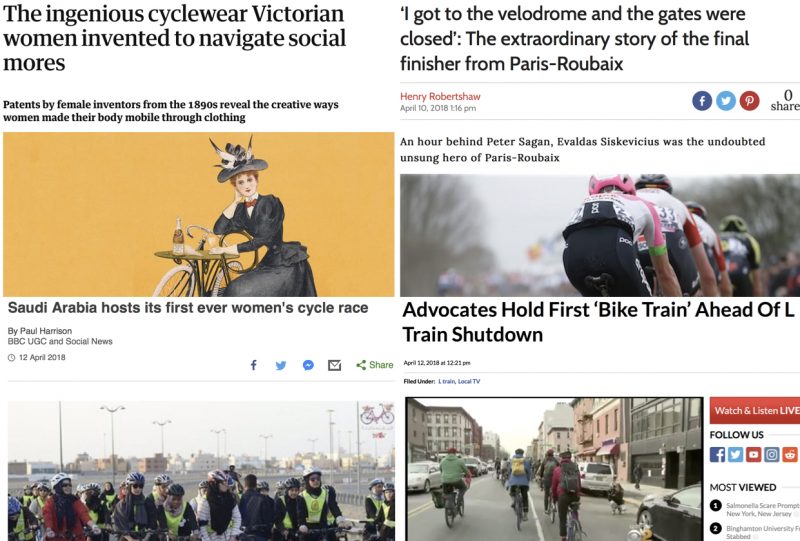
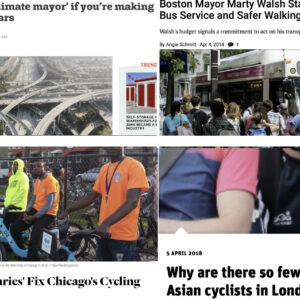
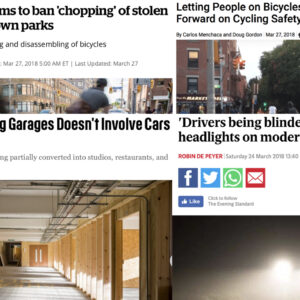
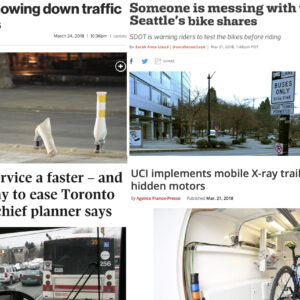
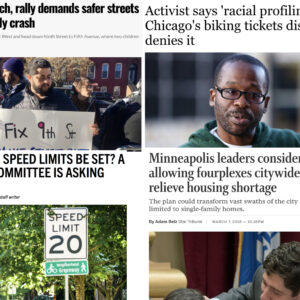
Thanks for reading.
BikePortland has served this community with independent community journalism since 2005. We rely on subscriptions from readers like you to survive. Your financial support is vital in keeping this valuable resource alive and well.
Please subscribe today to strengthen and expand our work.
The bikesnob piece is excellent and hilarious.
“Consider traffic lights. Bike-haters are fond of saying cyclists only treat red signals as suggestions. Frankly, I wouldn’t even go that far. When I’m on my bike, I regard traffic lights the same way a dog regards an alarm clock: it doesn’t mean shit to me personally, though I am quite invested in the behavior it inspires in those around me. See, Buddy the golden retriever doesn’t care what time it is or when your morning meeting starts. All he knows is that when your alarm goes off, you’re going to press that big button three more times before he finally gets to go out and take a leak. So he plans accordingly.”
It’s nice to see how bikesnob has grown over the years from a law-abiding “Fred” to a proud scofflaw.
Yes, truly delightful.
Yet you frequently point out which laws drivers should be obeying.
When operating a motor vehicle, one should obey all the laws. Vehicle codes were instituted because motor vehicles can kill and maim people, not because the longer-established cyclists and even longer-established pedestrians were causing harm.
You don’t get to pick and choose which laws you obey and which laws you don’t. Pretty much our whole society is based on that premise.
“You don’t get to pick and choose which laws you obey”
That is precisely how democracies function, MotRG.
Democracies give you a voice in determining the laws, but you should obey those that have been adopted.
Except that laws are constantly changing. New ones introduced, old ones thrown out, etc.
Tell that to PBOT re: Oregon’s parking laws.
Civil Disobedience
Henry David Thoreau – 1849
http://xroads.virginia.edu/~hyper2/thoreau/civil.html
Did you read the article? The reason cyclists disobey traffic laws is because the infrastructure is hostile to them, making it difficult to obey the law and stay safe at the same time. And cyclist lawbreaking is directly correlated to the quality of the infrastructure: “‘“Cities get the cyclists they deserve. If you have good infrastructure, you will get good cyclists.'”
Work to change the laws. If people see you disobeying them you pretty much have zero credibility in anything you point out they are doing wrong. Comes across as “Do as I say, not as I do.”
It’s not the laws that need changing. It’s the infrastructure favoring cars over others that make the laws unfair to those not in cars And yes, we have been working on that for years.
Also, how is a red light hostile to you?
It’s giving me the evil eye.
The stops signs are even worse. Everyone knows writing all caps is like yelling. Yelling STOP at every cyclist that passes through an intersection is very hostile. No wonder some people feel so vicitimized… 😉
A red light is hostile to me if I have to go out of my way to push a button to make that red light go away, while drivers don’t. As a pedestrian particularly, I often find myself having to wait an extra cycle after pushing the Beg Button, while cars traveling parallel to me – many of which arrived at the intersection after me – get to sail through. Giving priority to people in cars over me is an act of hostility.
A red light is hostile to me if it makes me stop at a dangerous intersection where the bike lanes have been removed to make more room for turning cars.
A red light is hostile to me if it puts me in a position to get right-hooked by drivers turning right on red.
Note that except when crossing with the aid of a button, green lights present the same injustices as red ones.
Sounds like you have it tough.
Actually they don’t. You’d know that if you read what BikeSnob specifically wrote about red lights.
“Sounds like you have it tough.”
It’s not about whining about my predicament. It’s that I’ve spent a lot more time as a pedestrian and a somewhat less as a cyclist the last few months, and I’ve become a lot more aware of how radically biased the transportation system is against pedestrians in particular. There are very strong disincentives against walking in our system, and a lot of privileges that drivers get over everyone else. Too bad if that’s so hard for you to see.
You mean the “it [traffic light] doesn’t mean s*** to me personally” and “To put it another way: if you want cyclists to follow the law, you’ve got to make it possible for them to do so without dying. ”
If being a cyclist or a ped is that hard, you’re doing something wrong. I’ve known a lot of cyclists and peds and get around town almost exclusively by human power and haven’t met any that feel that way except here.
When someone on the other side of the country whose only true claim to fame is being an internet loudmouth is cited as an authority on something that almost no one finds confusing, that should tell you something.
Kyle’s perennial response to someone who does not cycle like them…
What would you do in place of buttons? Given there is no other way (or at least not until recently) to reliably detect the presence of a pedestrian, the only alternative is to have the walk signal illuminate at every phase. This may make sense in some contexts (and is done at many many crossings), but in places where pedestrian activity is low, it really makes no sense from a systems operation standpoint. Much of the time, you’d be delaying people for no reason.
A lot of what you are complaining about is our technology, and the inherent nature of pedestrians taking longer to clear an intersection than a car or a bike. Perhaps it would be reasonable to start with the question of how much should we delay a person in a car to save a pedestrian 1 second? Then we could look at a particular intersection, with its vehicle and pedestrian flows, and see how it compares.
My diagnosis is different than yours: I think our systems are limited by equipment and lack of creativity, rather than bias. I think it would be possible to optimize certain crossings in a way that made signals much more responsive to pedestrians, without impacting vehicle flow at all, if only someone had the vision to do so.
Whether intentional or not, it is de facto bias. As a pedestrian I spend a lot more time stopped waiting at lights than when covering the same distance in a car. Or a bike.
In the city it’s not too bad, and maybe that’s why there are several comments here from people saying they don’t see what I’m seeing. But spend significant time walking in places like Beaverton or Hillsboro – as I do – or other suburban areas around the country, and you’ll find the infrastructure is quite burdensome to pedestrians.
I understand the idea removing the pro-car biases in many of our signal timing regimens would cause delay for more drivers than the number of pedestrians who would benefit, but to some degree that’s getting cause and effect mixed up. One of the reasons so few people walk in places where beg-buttons predominate is precisely because the infrastructure discourages walking. When you have to wait an extra 90 to 120 second cycle to get across every intersection, and crossings of major roadways are minutes apart by foot, of course few people walk. And of course pedestrians cross against the light.
Also, to answer the question more directly about what to do in place of buttons:
– When major roadways intersect minor roadways, the parallel WALK can be enabled to come on every cycle (at least during the signals’ daytime programs) without substantial delay to vehicles, since the parallel vehicle movement tends to carry enough traffic to let the green last as long as the WALK anyway.
– When a pedestrian hits the button after the beginning of the parallel vehicle green, the signal could still enable the WALK if it won’t extend the green beyond its maximum setting for the current program. Approaching vehicles have the capability of extending the green, potentially to several times its minimum duration; pedestrians should also have that capability. I’ve seen a few intersections where this can occur, but it appears not to be common practice among local transportation agencies to enable it. This is an example of local staff not being trained or, as you put it, lacking the imagination or awareness to help level the playing field.
– Pedestrian-detection technology is available now, and would be relatively inexpensive if demanded in volume. We’ve spent an awful lot of money on vehicle detectors to make signal timing much snappier for automobiles than it was a generation ago, even though the in-pavement loops that are most commonly used are very labor-intensive to install and maintain. In a relative sense adding pedestrian-detection technology wouldn’t be that much to spend, if mandated in the MUTCD. Countdown timers would have seemed an outrageous expense 10 or 15 years ago, but nine years after being mandated in the 2009 MUTCD they’re nearly standard now.
Parallel walk enabled — I totally agree, and this is frequently done, even on streets crossing monstrosities such as Powell. It is not done, though, at those same intersections for crossing Powell, so there must be a reason. My guess is engineers want to make extra sure someone isn’t caught in the middle of Powell because they started walking when when the signal was almost over, which is much more likely to occur if the signal is flashing rather than solid. So this may be a safety thing more than a bias thing.
Walk in mid-phase — Again totally agree, but I’ve never seen it anywhere. I’m going to chalk this one up to equipment limitations (otherwise, surely, someone would have done it and I would have encountered it at least once on my fairly wide-ranged roaming). Also unnecessary if parallel walk is automatic.
Pedestrian detection tech — Once again… totally agree. If the tech is reliable and durable and not too expensive, I’d expect to see it around more. It would certainly cost more, and you’d need the button anyway (in case the auto equipment failed, unless it was rock solid). I think this is inevitable.
I would actually go farther; I’d like to see a signal stay green for autos as long as possible, “saving” time for pedestrians. Then, when a ped arrived, if there was sufficient time in the bank, the signal would switch immediately, even if there had just been another ped phase 10 seconds prior. Walk signals could be extended by pressing the button again if sufficient time were banked. Of course there would need to be limitations, but the idea would make the signals feel much more responsive (usually), and would not change throughput.
I really don’t mind pressing a button; it’s what happens next that is important.
“totally agree. If the tech is reliable and durable and not too expensive”
I’m going to play devil’s advocate for a moment. Why should it only be done if it is not too expensive? Remember those enormous digital reader boards ODOT put up all over the metro area freeways, some dozen years or so ago? Well no one asked for those. ODOT had to think up a constituency to assign them to. And they cost a fortune.
Here’s some history on the thinking with those digital boards:
https://bikeportland.org/2014/12/15/guest-article-four-things-bikeloudpdx-learned-campaign-se-clinton-117493#comment-6003599
Looks like they haven’t been around as long as I’d thought.
One should always weigh the costs against the benefits. That it is not always done in a way that you or I might agree with does not mean the principal should be abandoned.
I might be tempted to agree in general, but I tried to show that in the case of those silly boards ODOT did nothing of the sort. They just went looking for a way to spend money, a lot of money.
Or a quote from a sage named Nick Gravenites, “Well, now, rules are alright when there’s someone left to play the game.”
The opinion of that Staten Island op-ed writer on cycling infrastructure is “We need all the asphalt we can get. We’re taking those lanes back. “.
Stuck in the last century.
It stuns me though how many people think this way. I was just at a meeting last week where people were talking about how to log more steps on their fitbits – the suggestions were all cumbersome stuff revolving around the car. ‘Park farther away from the store,’ ‘Drive to the park and take a walk,’ and my personal favorite, ‘take your grocery bags in from the car one at a time.’ I suggested maybe people try walking to the grocery store instead, which prompted looks of horror and one woman’s account of trying that one time, then forgetting she didn’t have a car with her and buying too much stuff. She called her husband to drive over and come get her. In my yoga class, the instructor used as an example of total awareness the idea that if you wait for someone to completely cross the street before putting the pedal back to the metal, you may think you are being generous to the pedestrian, but at the same time, you are burdening the driver behind you, who wants to get where he’s going as fast as possible. Most people are so far from being able to conceive of going carless that it’s hard to imagine how we will ever get to carless or even car-lite without some violent cataclysm that forces people out of their cars. There is actual fear associated with going carless for many people – even those who live in areas where they could at the very least ditch the car on work days. I think Mr. Staten Island’s assessment would resonate with a lot of people, even if their consciences made that resonation a guilty pleasure, and that is a shame and a worry.
“you may think you are being generous to the pedestrian, but at the same time, you are burdening the driver behind you, who wants to get where he’s going as fast as possible.”
Sounds like a win-win situation. Thank your yoga teacher for doubling the enjoyment I feel for stopping and waiting for pedestrians to cross the street.
The fact that its Oregon law is inco sequential to the feel good dopamine hit
Ha! 🙂
I read the article as satire. The writer was just making the point that if the city can ignore federal law, why can’t a borough ignore city law. My guess is that public transit on Staten Island consists of only buses. So public transit is stuck in the same traffic as everyone else.
Love seeing bike trains in the news! hope all those riders have fun.
On my machine, the link for the “why bike riders break traffic laws” is
https://www.outsideonline.com/2294891/art-wayfinding
If I was the mayor of NYC I think I would sell Staten Island to New Jersey and use the money to put in a temporary floating bridge to Brooklyn just for bikes during the L train shutdown.
The hut and run incident in LA during a vigil for a cyclist killed at the same intersection a few days before is appalling. The guy was thrown into the air and managed to hop to the other side of the street while onlookers came over to help him out. The motorist missed several other people there and his action was witnessed not only by a large crowd, but by crews for several LA area TV stations as well. The vigil was similar to the one in Portland last year on Hawthorne Blvd. The motorist is still at large, as I understand it. The driver hopefully will be found and prosecuted for his actions.
Heck, a news cameraman had to jump out of the way to avoid being another victim! What’s worse is how the officer at the scene somewhat explained away the actions of the driver. Saying that she may have fled the scene because she feared for her safety. Yes, some of the protesters were acting violent, but the problem is that she had already left the scene, then came back later to drive through the crowd and appeared to be trying to hit someone – and did. That seems premeditated, and she should be charged with attempted murder.
Regarding steering public transit spending towards serving the “working class”: If the size of the public transit money pie was fixed, this strategy would make perfect sense. However, it’s not. If we design and build transit primarily to serve the poor, using transit will be a mark of being poor, something few people aspire to. If we design and build it to serve everyone, then we may well bring some of the folks who are making key decisions on board. This could elevate transit funding and normalize transit use.
I’ve lived where transit sees a socioeconomic mix, and it’s generally better supported than places like my current location that sees transit as something for the poor to use.
Unfortunately, a strategy of serving all classes equally will leave a void for working class folks that will last years.
Or we could try to reduce inequality(!)
The US is one of the most unequal societies in the world, and less equal than all of the countries we normally compare ourselves to.
We should do both.
The primary cause of increasing wealth (capital income) inequality in european and anglo nations is ownership of single family homes.
https://voxeu.org/article/piketty-s-housing-capital-results-new-us-facts
It’s hardly surprising that buying property for yourself is financially better than buying it for somebody else.
Ownership of single family homes are why we have ever more billionaires, while incomes are stagnant for the bottom half?
“incomes are stagnant for the bottom half”
that’s what the economic literature suggests.
9, you bring up one of my favorite topics…how do we measure equality?
An excellent recent book on the topic, with an unfortunate title:
https://en.m.wikipedia.org/wiki/The_Spirit_Level_(book)
By comparing the relative wealth of various percentiles of the population? Really not very complicated for anyone who’s taken a basic statistics class.
Finally got around to reading the “Sanctuary!” piece. That guy is something. First he claims that they don’t need the “ridiculously low 25 mph city speed limit”, his reasoning implying that the roads aren’t congested enough to warrant that. But then, only two sections down, he says that they shouldn’t have to respect the bike lanes if someone wants to park in front of a store or home because the roads are too congested!